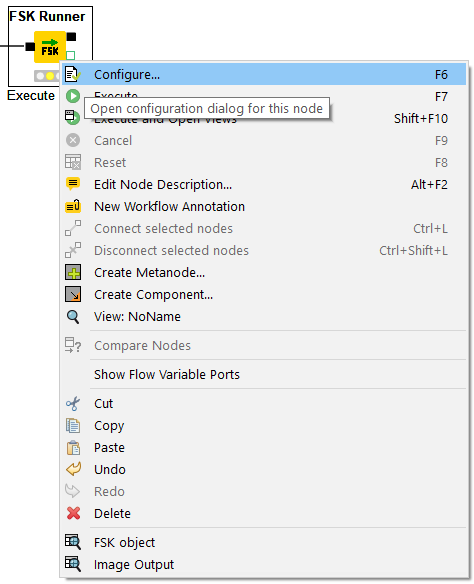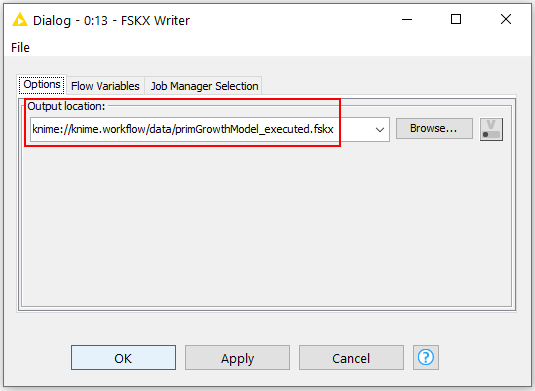Prefer video tutorials over written guides? Explore our video tutorials here.
This manual gives an instruction how to import and execute a FSKX compliant model with creating an own simulation setting in FSK-Lab.
1
Read in FSKX file of the model
- First the FSKX Reader node should be configured by opening the node context menu (right click on the node) and selecting the option Configure

- In the configuration dialog, define the file path by clicking the Browse button in order to provide the input location for the FSKX file of the model
- The FSKX file can be stored inside the current workflow data area (e.g. C:/knime-workspace/workflow/data/modelname.fskx), so that the KNIME URL knime://knime.workflow/data/modelname.fskx could be used as input location for the model
- In order to apply the file path settings, close the configuration dialog by clicking OK

- The FSKX Reader node can be now executed by selecting the option Execute from the node context menu

- The FSK object containing the metadata and scripts of the model can be viewed at the output port of the FSKX Reader node by selecting the option FSK object from the node context menu


2
Review of FSK object of the model
- The FSK object of the model can be reviewed and modified by using the FSK Editor JS node
- By selecting the option Execute and Open Views from the node context menu (right click on the node) a new window will open with a GUI that allows to inspect and adjust the metadata and scripts provided for the model

- The model details are presented in a structured form via different tabs

-
The GUI of the FSK Editor JS node can be closed and the changes saved by clicking on Close and Apply

3
Create a new simulation setting
- A FSKX compliant model allows to create and execute different simulation scenarios
- Therefore, parameters are defined by the model creator
- These parameters are used as variables within the model code
- The parameters are classified as input or output parameter
- There are two types of input parameters: variable and constant input parameter
- Each input parameter has an initial value, provided by the model creator, to generate the default simulation
- The values of the variable input parameters can be adjusted in order to create additional simulation scenarios

- A new simulation setting can be created by using the FSK Simulation Configurator JS node
- By selecting the option Execute and Open Views from the node context menu (right click on the node) a new window will open with a GUI that allows to review predefined simulation settings like the default simulation and to add new simulation scenarios

- A new simulation setting can be added by clicking on the Add simulation button

- For each new simulation setting a name has to be given
- The values of the parameters can be adjusted according to the scenario of interest
- It is possible that a range of valid values is predefined for a parameter based on a minimum and a maximum value
- Note: values of parameters which are classified as constant, cannot be modified
- Clicking on the i symbol provides available metadata for the corresponding parameter

- The newly created simulation setting has to be saved by clicking on the Save changes button

- The simulation selected in the view of the drop-down menu is set as simulation to be executed

- The GUI of the FSK Simulation Configurator JS node can be closed and the selection of the simulation for execution saved by clicking on Close and Apply

4
Execute the model with a selected simulation setting
- A FSKX compliant model can be executed by using the FSK Runner node
- First the FSK Runner node can be configured by opening the node context menu (right click on the node) and selecting the option Configure

- In the configuration dialog, a predefined simulation scenario can be selected for execution from the drop-down menu (defaultSimulation, additional simulation settings)
- If desired the output of the model can be saved to a JSON file by ticking the corresponding box
- In order to apply the execution settings, close the configuration dialog by clicking OK

- The JSON file parameters.json, generated after the execution of the FSK Runner node, will contain a list of all input and output parameters with their corresponding values

- The FSK Runner node can be now executed by selecting the option Execute and Open Views from the node context menu

- The plot of the model result, generated based on the visualization script, will be shown in a pop-up window (Image output)

- The model results will be stored in a R workspace if the model script is provided in the programming language R
5
Write the FSK object of a model with simulation results into FSKX file
- First the FSKX Writer node should be configured by opening the node context menu (right click on the node) and selecting the option Configure

- In the configuration dialog, define the file path by clicking the Browse button in order to provide an output location and a name for the FSKX file of the model
- The FSKX file can be stored inside the current workflow data area (e.g. C:/knime-workspace/workflow/data/modelname.fskx), so that the KNIME URL knime://knime.workflow/data/modelname.fskx could be used as output location for the model
- In order to apply the file path settings, close the configuration dialog by clicking OK

- The FSKX Writer node can be now executed by selecting the option Execute from the node context menu

- The harmonized file format FSKX is a ZIP container which includes all necessary files for the annotation and execution of the model (model metadata and model code)

6
An example KNIME workflow for this manual can be downloaded here.